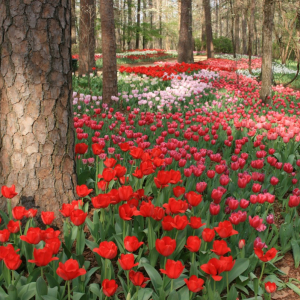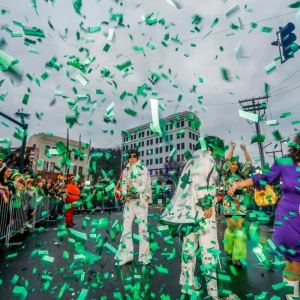Hot Springs History

From early exploration of its healing waters and the city’s infamous mobster past to its Major League appeal and Tri-Lakes reputation — there’s a lot to learn about Arkansas’ favorite tourist destination.
Paradise Found
Visitors can’t help but feel the thousands of years of history surrounding them in Hot Springs — history that continues to bubble up every minute. The hot spring water comes from rainwater that fell more than 4,000 years ago. It percolated 6,000 to 8,000 feet into the earth, where it became superheated by surrounding rock before rising and emerging at 143°F from the area’s 47 hot springs.

Central Avenue in Hot Springs between 1895 and 1910.
While no one knows when the first humans came to what is now Hot Springs, experts believe Native Americans were using the springs as a peaceful gathering spot as many as 10,000 years ago. The Native Americans called the area “the valley of the vapors,” where tribes could put aside their differences and enjoy the rejuvenation of the springs. Oddly enough, this area became “neutral ground” again in the 1930s when mobsters from Chicago, New York and Los Angeles came to fraternize together and get away from it all.
European Exploration

Spanish explorer Hernando de Soto is believed to be one of the first European visitors to what is now Hot Springs while on his quest for an earthly paradise — a fabled city of gold. Guided by Native Americans, he and his troops arrived in September 1541 to partake in the thermal springs. As far as it's known, de Soto was the last European visitor for more than 100 years, until French explorers Marquette and Joliet arrived in 1673 to claim the area for France. Possession seesawed between France and Spain until 1803, when the United States acquired it as part of the Louisiana Purchase.
American Settlement
In 1804, President Thomas Jefferson commissioned an expedition to explore the area. The explorers found a log cabin and a few rudimentary shelters used by people visiting the springs, but no permanent dwellers. In 1807, a man named Prudhomme became the first settler of modern Hot Springs, and John Perciful and Isaac Cates soon joined him.
Beneath Your Feet
For years, the springs flowed into Hot Springs Creek, which ran through the middle of the resort town. In the late 1800s, the creek was put into a channel and roofed over. Today, the creek flows under Central Avenue.
In 1820, the Arkansas Territorial Legislature requested the springs and the adjoining mountains be deemed a federal reservation. Congress established the Hot Springs Reservation on April 20, 1832, to protect the Hot Springs area. This makes Hot Springs the oldest park in the National Park System — 40 years older than Yellowstone.
In 1921, Congress changed the name of Hot Springs Reservation to Hot Springs National Park, which now encompasses 5,500 acres. The park includes famous Bathhouse Row, which consists of eight unique, turn-of-the-century bathhouses in the heart of downtown.

After a devastating fire in 1923, the Arlington was rebuilt better than ever with 560 rooms and a bathhouse.
A Resort is Born
Over the years, Hot Springs became famous for its therapeutic benefits. The area attracted more visitors and developed into a well-known resort nicknamed “The American Spa” because it attracted not only the wealthy but also health seekers from around the world. It was believed for hundreds of years that the natural thermal waters could cure any number of ailments, including arthritis and polio. The baths faded as a medical treatment with the advent of modern medical science, but people still came by the thousands for relaxation.
Famous visitors who have frequented Hot Springs range from boxing champion Jack Dempsey to performers Sarah Bernhardt, Liberace, the Smothers Brothers, Bill “Bojangles” Robinson and Presidents Theodore Roosevelt, Franklin D. Roosevelt and Harry Truman. It's reputed that Tony Bennett first performed his signature song “I Left My Heart in San Francisco” during a rehearsal at the Black Orchid Club in 1963. In the 1940s, actor George Raft could often be seen driving his convertible along Central Avenue.
Baseball Capital

During the late 19th and early 20th centuries, Hot Springs was the off-season capital for Major League Baseball. The Chicago Cubs, Pittsburgh Pirates, Brooklyn Nationals, Chicago White Stockings and Boston Red Sox all held spring training in Hot Springs. Babe Ruth first visited the Spa City as a young pitcher with the Red Sox, but returned often for baths and rounds of golf.
In celebration of these deep connections to America’s pastime, the city recently inaugurated the Historic Baseball Trail. A series of plaques and a smartphone-guided tour map out major moments in Hot Springs’ baseball history — like Babe Ruth’s first 500-foot-plus home run achieved while playing ball at Whittington Park.
The Gangster Era
From the 1920s through the 1940s, Hot Springs flourished as a place where the famous and infamous came to enjoy the thermal waters, luxury hotels and illegal gambling and bootlegging — especially in the 1930s. Gambling hotspots included The Ohio Club, Hot Springs’ oldest bar, and The Southern Club (now the location of the Josephine Tussaud Wax Museum), which was reputed to be owned by mobster Owney Madden. He was one of the founders of the New York mob, was part of Murder Inc. and owned Harlem’s famous Cotton Club.
The father of modern organized crime, Charles “Lucky” Luciano (left) was arrested behind Ozark Bathhouse. Al Capone (right) regularly visited Hot Springs, even taking up part-time residence in Suite 443 at The Arlington Resort Hotel & Spa. 
Illegal gambling was permanently shut down in Hot Springs in 1964, thanks to a federal crackdown on what the government called “the site of the largest illegal gambling operation in the U.S.”
Bathhouse Row
One of the most notable Hot Springs features is Bathhouse Row, which consists of a series of eight historic, architecturally unique bathhouses lining Central Avenue.
The Fordyce Bathhouse, built in 1915, is one of the most recognizable of the eight and serves as the Hot Springs National Park Visitor Center. The Fordyce Bathhouse is the largest and most ornate of all the bathhouses in town.

In 1922, the Quapaw Bathhouse was built in the Spanish Colonial Revival style and boasts a large Moorish-style dome capped with a copper cupola. Possibly the most interesting aspect is the basement grotto containing the Quapaw Spring, which serves as a natural steam room for the bathhouse today.
Buckstaff Bathhouse, built in 1912, is the oldest bathhouse still in operation. It was built in the Neoclassical Revival style, with engaged Tuscan columns that divide the main façade into seven bays flanked by pavilions at the north and south ends.
Water Wonder

In 1871, pharmacist Peter Greene and his brother John bought Lockett Springs in Hot Springs and began selling mineral water they called Mountain Valley Spring Water. By 1928, the water’s popularity and association with the health spa boom allowed the company to expand distribution — making Mountain Valley the first bottled water available coast to coast. Famous fans of the water include Frank Sinatra and Elvis Presley, and it was even the choice of the U.S. Senate in the 1920s. Today, visitors can explore the company’s rich history at Mountain Valley's Museum of Bottled Water. The museum showcases nearly 150 years of bottles, barrels, photographs, specialized machinery and more.
African American Legacy
Prior to the civil rights movement, Hot Springs’ bathhouses were racially segregated, with the best bathhouses catering to white people. Despite the injustices segregation caused, the city saw a flourishing of African American bathhouses after the turn of the century.

The Crystal Bathhouse, built in 1908, was the first Black bathhouse in the city and operated until a fire destroyed it in 1913. The Pythian Bathhouse & Sanitarium (pictured right) opened on the site of the old Crystal Bathhouse the next year and served patrons — including many Black celebrities — until 1974.
Perhaps the grandest bathhouse of them all, the Woodmen of the Union, opened in 1922 with first-class hotel accommodations, a 2,000-seat theater and a steady stream of entertainers and celebrities during its heyday.
By the Numbers
47 - the number of hot springs in the Spa City
1541 - the year Hernando de Soto visited Hot Springs
140 miles - the distance you can see in all directions from the top of Hot Springs Mountain Tower
2 - the number of still-operational bathhouses on historic Bathhouse Row
1803 - the year the United States acquired Hot Springs as a part of the Louisiana Purchase
143°F - the temperature of the Spa City’s thermal mineral water
5,500 - the number of acres within Hot Springs National Park
5 - the number of MLB teams that held spring training in Hot Springs in the late 19th and early 20th centuries







